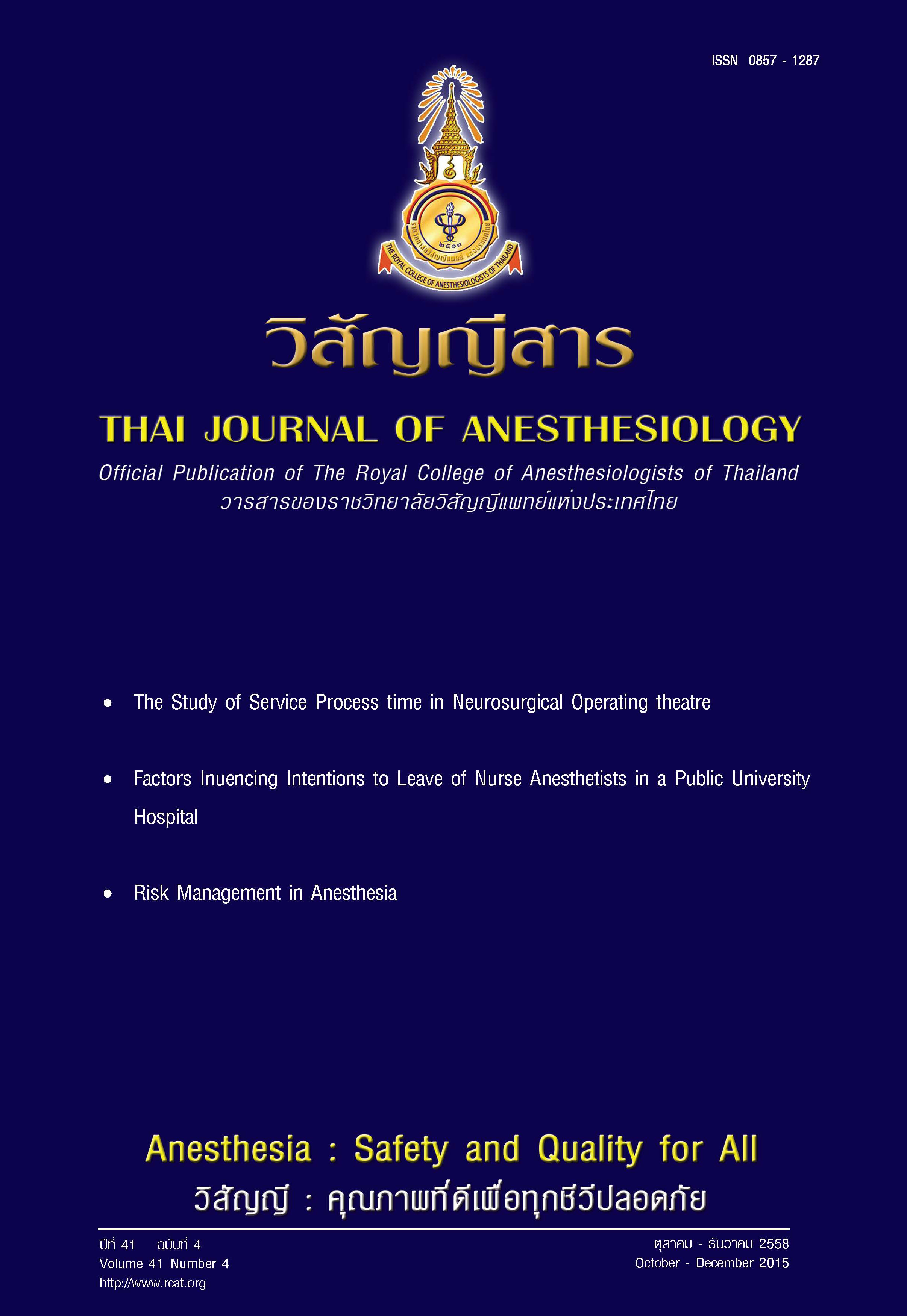The study of service process time in neurosurgical operating theatre
Main Article Content
Abstract
Objective: To study the service time and to evaluate the effectiveness of neurosurgical operating theatre utilization at Prasat Neurological Institute.
Methods: The service related data at Prasat Neurological Institute, e.g. human resource workload, patient demography and utilization time according to the definitions were collected by 2 observers during 3 months period from February 1st- April 30th 2012. The descriptive statistical analysis was done and demonstrated in number, percentage, means and standard deviation. The ANOVA test and post hoc analysis with Bonferroni method was analyzed to differentiate time spent between patient categories and positioning. Pearson’s correlation was calculated and shown in r2 to determine the relationship of the possible factors and utilization rate. P-value < 0.05 was considered statistically significant.
Results: The mean surgical time, anesthesia time, allocated theatre time and change over time were 157.33±126.24, 205.24±138.59, 178.41±112.15, and 17.51±8.02 minutes respectively while the mean arrival time, preoperative waiting time, monitoring time, time to anesthetic release and positioning/draping time were 22.59±13.40, 28.14±27.44, 8.38±8.20,12.20±7.44 and 38.20±21.06 minutes in order. There was a statistically significant difference in surgical time, anesthesia time, preoperative waiting time and positioning/draping time according to patient category and positioning. The effectiveness of operating theatre utilization was 69.14±31.68%. The negative overload index was 22.13±14.21% while the optimization index and resistance index were 160% and 49.68% accordingly.
Conclusion: The effectiveness of neurosurgical operating theatre at Prasat Neurological Institute utilization was not achieved the 80-85% goal but these data and studying indexes could be adapted to achieve the strategic quality and directed to develop further goal.
การศึกษาระยะเวลาของกระบวนการบริการในห้องผ่าตัดทางระบบประสาท
วัตถุประสงค์: การศึกษานี้จัดทำขึ้นเพื่อศึกษาระยะเวลาในการให้การบริการผู้ป่วยในห้องผ่าตัด และ ประเมินความคุ้มค่าของการใช้ห้องผ่าตัดทางระบบประสาทสถาบันประสาทวิทยา
วิธีการศึกษา: ทำการเก็บ ข้อมูลการปฏิบัติงานที่เกี่ยวข้องในห้องผ่าตัดทางระบบประสาทสถาบันประสาทวิทยา เช่น ข้อมูลด้านอัตรา กำลัง ข้อมูลผู้มารับบริการ ระยะเวลาในการให้บริการ เป็นระยะเวลา 3 เดือนตั้งแต่ 1 กุมภาพันธ์ - 30 เมษายน พ.ศ. 2555 โดยมีผู้เก็บบันทึกข้อมูล 2 คน เฝ้าสังเกตและบันทึกเวลาในช่วงต่างๆ ตามคำนิยาม ข้อมูลทั้งหมด นำมาวิเคราะห์ตามหลักการทางสถิติ โดยการใช้สถิติเชิงพรรณนา แสดงผลในรูปของจำนวน ร้อยละ ค่าเฉลี่ย และค่าเบี่ยงเบนมาตรฐานคำนวณหาความแตกต่างระหว่างกลุ่มตามประเภทผู้ป่วยและการจัดท่าด้วย วิธี ANOVA วิเคราะห์ post hoc ด้วย Bonferroni method และหาความสัมพันธ์ของปัจจัยต่างๆ ที่เกี่ยวข้องกับ ตัวชี้วัดอัตราการใช้ห้องผ่าตัด โดยใช้ Pearson’s correlation ถือว่ามีนัยสำคัญทางสถิติเมื่อ ค่า p-value < 0.05 แสดงผลในรูปของค่า r2
ผลการศึกษา: พบว่าค่าเฉลี่ยของระยะเวลาในการผ่าตัด ระยะเวลาในการให้ยาระงับ ความรู้สึก ระยะเวลาในการใช้ห้องผ่าตัดตามกำหนดการ และระยะเวลาที่ผู้ป่วยออกจากห้องผ่าตัดจนกระทั่ง ผู้ป่วยรายใหม่เข้าห้องผ่าตัด มีค่า 157.33±126.24, 205.24±138.59, 178.41±112.15และ 17.51±8.02นาที ตามลำดับ ระยะเวลาที่ผู้ป่วยมาถึงห้องผ่าตัด 22.59±13.40 นาที ระยะเวลารอเข้าห้องผ่าตัด 28.14±27.44 นาที ระยะเวลา ในการเตรียมผู้ป่วยเพื่อการเฝ้าระวัง 8.38±8.20 นาที ระยะเวลาเสร็จสิ้นการเริ่มการให้ยาระงับความรู้สึก 12.20±7.44 นาทีระยะเวลาจัดท่าและปูผ้าปราศจากเชื้อ 38.20±21.06 นาที โดยระยะเวลาในการผ่าตัด ระยะเวลา ในการให้ยาระงับความรู้สึก ระยะเวลารอเข้าห้องผ่าตัดและระยะเวลาจัดท่าและปูผ้าปราศจากเชื้อ มีค่าแตกต่าง กันอย่างมีนัยสำคัญตามประเภทของผู้ป่วยและชนิดของการจัดท่าเพื่อทำการผ่าตัด เมื่อประเมินความคุ้มค่าใน การใช้งานห้องผ่าตัด พบว่าอัตราการใช้ห้องผ่าตัดตามจริงมีค่า 69.14±31.68% โดยตัวชี้วัดอัตราการใช้ห้องผ่าตัด มีค่าเป็นลบมีค่า 22.13±14.21% ตัวชี้วัดที่ทำให้เวลาในการใช้ห้องผ่าตัดเหมาะสมมีค่า 160.00% ส่วนตัวชี้วัดที่ ทำให้เวลาในการใช้ห้องผ่าตัดช้าลงมีค่า 49.68%
สรุปผล: ความคุ้มค่าของการใช้ห้องผ่าตัดของสถาบันประสาท วิทยายังไม่ถึงเป้าหมายที่ตั้งไว้ที่ประมาณร้อยละ 80-85 แต่ทั้งนี้ข้อมูลที่มีคุณภาพรวมทั้งตัวชี้วัดที่ทำการศึกษา สามารถนำมาประยุกต์ในการวางแผนให้เกิดการพัฒนางานและกำหนดเป้าหมายที่เหมาะสมต่อไปได้


